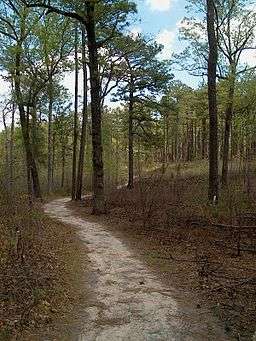Sandhills (Carolina)

The Sandhills is a region in the interior of the U.S. states of North Carolina and South Carolina. It is a strip of ancient beach dunes which generally divides the Piedmont from the coastal plain, and is the evidence of a former coastline when the ocean level was higher, or the land lower. The beach deposits were formed principally during the Miocene Epoch, about 20 million years ago. Typical beach fossils are found along the front edges. The coastal plain is terraced from other ocean levels, but none appear to have been so long-lasting, so as to build up dunes of this size.
Vegetation
Because they are predominantly porous, sandy soils, the area tends to be droughty and irrigation is required for agriculture. Some areas are noted for peach production, primarily because peaches need a well drained soil.
Prior to agricultural use, most of the Sandhills were forested with longleaf pine, loblolly pine, turkey oak, and blackjack oak. In areas of extreme drainage, the forests are visibly scrubby. Oaks increase under conditions of wildfire exclusion, whereas longleaf pine will dominate under a regime of frequent fires. Understory vegetation is of plants that are well adapted to droughty conditions, as well as the frequent lightning-induced fires typical of the region. Wiregrass (Aristida spp.) is frequently extensive in the understory. Carnivorous plants, especially pitcher plants, often occur in the herb layer.
Wildlife
Due to extensive environmental impact of man, such as fire suppression, loblolly pine tree farming, and habitat reduction/fragementation, many Sandhills plants and animals are now threatened or endangered. Notable vertebrates of the Carolina Sandhills include the locally threatened gopher tortoise and red-cockaded woodpecker, as well as the northern pine snake, Bachman's sparrow, pine barrens tree frog, and fox squirrel.
Preservation
The Carolina Sandhills National Wildlife Refuge in northeastern South Carolina attempts to preserve a fraction of the original Sandhills longleaf pine ecosystem. The refuge is located in Chesterfield County near McBee.
Socioeconomic region in North Carolina
The Sandhills region of North Carolina, in socioeconomic terms, most notably refers to the area in and surrounding the municipalities of Southern Pines, Pinehurst, and Aberdeen (i.e. Moore County). The area is famous for its golf courses and history in the sport of golf. The city of Fayetteville is sometimes considered part of the Sandhills, but it is isolated from the heart of the region by Fort Bragg Military Reservation. The Sandhills continues along the U.S. 1 corridor through Cheraw, Columbia and Aiken in South Carolina and Augusta, Georgia.
The counties included in this region that hosts longleaf pines and sandy soil are western Cumberland, western half of Harnett, much of Lee, central and southern two-thirds of Moore, much of Richmond, northern & western areas of Scotland, western and central Hoke, extreme western Robeson, southeastern Chatham and the southeastern part of Montgomery. Southwestern Wake County also could be considered the Sandhills due to the similar ecology of the region but isn't referred to it by the locals of Holly Springs, New Hill community and Fuquay-Varina.
The population of this region in North Carolina as of the 2010 census was 877,548.
References and external links
- Aspects of NC Climate--Carolina Sandhills—accessed 19 March 2007
- Carolina Sandhills National Wildlife Refuge—accessed 19 March 2007
- Carolina Sandhills National Wildlife Refuge (Brochure)—accessed 19 March 2007
- Carolina Sandhills National Wildlife Refuge--fire management—accessed 19 March 2007
- Carolina Sandhills National Wildlife Refuge--flora and fauna—accessed 19 March 2007
- South Carolina Naturally—accessed 19 March 2007
- Sandhills--Nature Conservancy—accessed 19 March 2007
- Sandhills Fact Sheet—Savannah River Ecology Laboratory—accessed 19 March 2007
- South Carolina Department of Environmental Resources—Sandhills Ecoregion Terrestrial Habitat—accessed 19 March 2007.